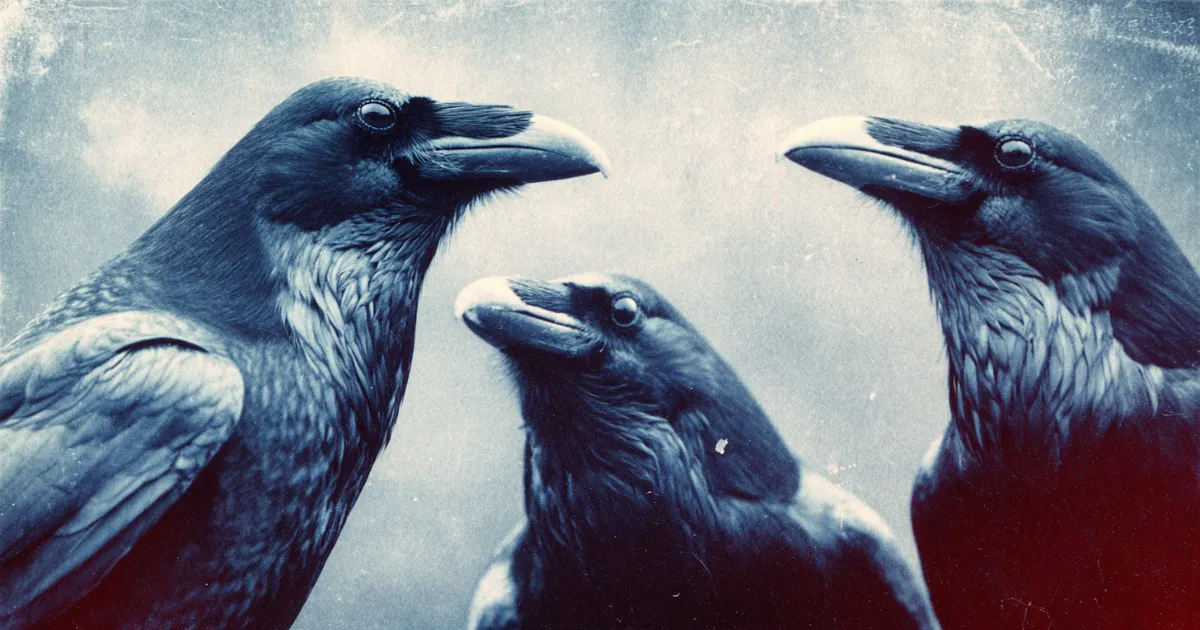
© History Oasis
Discover the fascinating world of intelligent corvids through these remarkable stories of famous crows and ravens—showcasing their problem-solving abilities, unique personalities, and surprising interactions with humans.

Betty, a crow at the Oxford laboratory, made headlines in 2002 for her remarkable tool-making abilities.
In a groundbreaking demonstration of avian intelligence, she spontaneously bent a straight piece of wire into a hook shape to retrieve food from the bottom of a well, showcasing problem-solving skills previously thought to be limited to great apes.

Charles Dickens had a pet raven named Grip who could talk, bury coins and cheese in the garden, and terrorize the family dog by stealing its dinner.
After Grip died from lead poisoning in 1841 after consuming a large amount of paint, Dickens had her stuffed and mounted above his desk, where she remained until his death and later sold at auction for 120 guineas.

Canuck the Crow, a wild Northwestern Crow from Vancouver, became a local celebrity and internet sensation from 2015 to 2019 due to his unusually close interactions with humans and bizarre antics.
Among his most outrageous exploits, Canuck stole a knife from a crime scene, interrupted police investigations, rode the Vancouver SkyTrain, and was even voted Metro Vancouver's unofficial ambassador in 2018, beating out actor Michael J. Fox with 81% of the final vote.

In 2015, an 8-year-old girl named Gabi Mann from Seattle formed an extraordinary relationship with the neighborhood crows, feeding them daily and receiving an array of small trinkets as gifts in return.
The crows had an apparent ability to recognize and reward Gabi's kindness, even going so far as to return a lost lens cap to Gabi's mother by rinsing it in their birdbath before leaving it for her to find.

The making of Alfred Hitchcock's 1963 film "The Birds" was fraught with challenges, including the use of over 25,000 live birds that attacked cast and crew members, sending 12-13 people to the hospital in a single day.
Lead actress Tippi Hedren endured relentless harassment from Hitchcock himself, culminating in a week-long ordeal where live birds were thrown at her for eight hours a day, with some even tied to her clothes, leading to her emotional breakdown on set.

In 2018, researchers discovered that New Caledonian crows could create compound tools by combining multiple parts, an ability previously only observed in humans and great apes.
One crow named Mango even demonstrated the remarkable skill of constructing tools from up to four separate components, showcasing problem-solving abilities that in human development only emerge reliably at around age five.

The ravens of the Tower of London, a group of at least six captive birds, are steeped in legend and superstition, with a belief that "if the Tower of London ravens are lost or fly away, the Crown will fall and Britain with it."
While the earliest known reference to captive ravens at the Tower dates back only to 1883, some of the birds have demonstrated remarkable behavior, including one raven named Edgar Sopper who convincingly played dead to attract attention, only to bite the ravenmaster's finger when picked up and fly off "croaking huge raven laughs."

Huginn and Muninn, Odin's pair of ravens in Norse mythology, served as his eyes and ears by flying across the world each day to gather information.
These intelligent birds were said to have the power of speech, whispering their collected knowledge directly into Odin's ears, and their names literally translated to "thought" and "memory"—suggesting they may have been metaphorical representations of Odin's cognitive functions rather than literal birds.

007 a Japanese crow, first observed exploiting urban environments around 1990, ingeniously learned to use cars as nutcrackers by dropping walnuts at traffic lights and waiting for the green signal to safely collect their snacks.
This mind-blowing behavior not only spread to other regions like California but also revealed the crows' ability to deceive each other by fake-hiding food when being watched, showcasing their remarkable problem-solving skills and social complexity that rivals that of many primates.